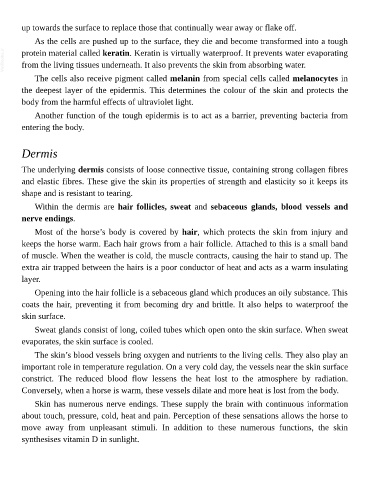Page 814 - The Veterinary Care of the Horse
P. 814
up towards the surface to replace those that continually wear away or flake off.
As the cells are pushed up to the surface, they die and become transformed into a tough
VetBooks.ir protein material called keratin. Keratin is virtually waterproof. It prevents water evaporating
from the living tissues underneath. It also prevents the skin from absorbing water.
The cells also receive pigment called melanin from special cells called melanocytes in
the deepest layer of the epidermis. This determines the colour of the skin and protects the
body from the harmful effects of ultraviolet light.
Another function of the tough epidermis is to act as a barrier, preventing bacteria from
entering the body.
Dermis
The underlying dermis consists of loose connective tissue, containing strong collagen fibres
and elastic fibres. These give the skin its properties of strength and elasticity so it keeps its
shape and is resistant to tearing.
Within the dermis are hair follicles, sweat and sebaceous glands, blood vessels and
nerve endings.
Most of the horse’s body is covered by hair, which protects the skin from injury and
keeps the horse warm. Each hair grows from a hair follicle. Attached to this is a small band
of muscle. When the weather is cold, the muscle contracts, causing the hair to stand up. The
extra air trapped between the hairs is a poor conductor of heat and acts as a warm insulating
layer.
Opening into the hair follicle is a sebaceous gland which produces an oily substance. This
coats the hair, preventing it from becoming dry and brittle. It also helps to waterproof the
skin surface.
Sweat glands consist of long, coiled tubes which open onto the skin surface. When sweat
evaporates, the skin surface is cooled.
The skin’s blood vessels bring oxygen and nutrients to the living cells. They also play an
important role in temperature regulation. On a very cold day, the vessels near the skin surface
constrict. The reduced blood flow lessens the heat lost to the atmosphere by radiation.
Conversely, when a horse is warm, these vessels dilate and more heat is lost from the body.
Skin has numerous nerve endings. These supply the brain with continuous information
about touch, pressure, cold, heat and pain. Perception of these sensations allows the horse to
move away from unpleasant stimuli. In addition to these numerous functions, the skin
synthesises vitamin D in sunlight.

